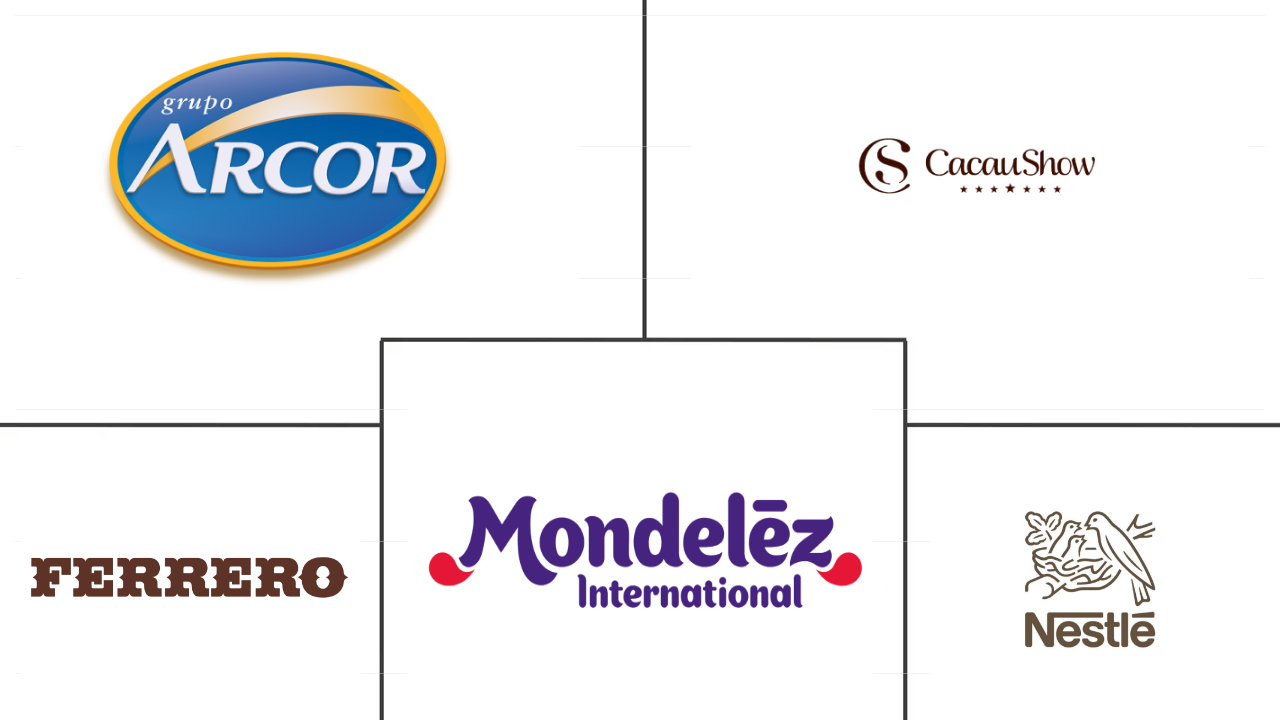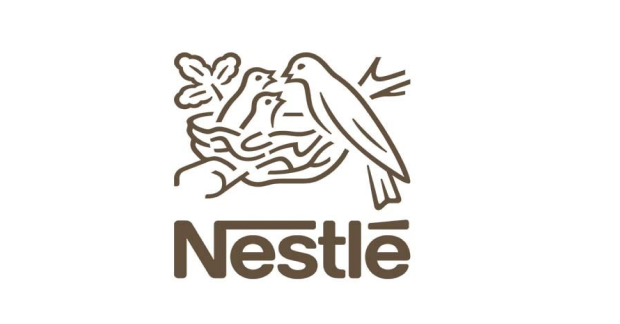Market Size of brazil chocolate Industry
| Icons | Lable | Value |
|---|---|---|
|
|
Study Period | 2018 - 2030 |
|
|
Market Size (2024) | USD 4.04 Billion |
|
|
Market Size (2030) | USD 5.23 Billion |
|
|
Largest Share by Distribution Channel | Supermarket/Hypermarket |
|
|
CAGR (2024 - 2030) | 4.38 % |
|
|
Fastest Growing by Distribution Channel | Online Retail Store |
|
|
Market Concentration | High |
Major Players |
||

|
||
|
*Disclaimer: Major Players sorted in no particular order |
Brazil Chocolate Market Analysis
The Brazil Chocolate Market size is estimated at 4.04 billion USD in 2024, and is expected to reach 5.23 billion USD by 2030, growing at a CAGR of 4.38% during the forecast period (2024-2030).
4.04 Billion
Market Size in 2024 (USD)
5.23 Billion
Market Size in 2030 (USD)
1.01 %
CAGR (2018-2023)
4.38 %
CAGR (2024-2030)
Largest Segment by Confectionery Variant
61.91 %
value share, Milk and White Chocolate, 2023
The innovative flavor offerings possible in white chocolate, followed by the preference for varied taste profiles in the region, are anticipated to drive segmental growth.
Largest Segment by Distribution Channel
41.32 %
value share, Supermarket/Hypermarket, 2023
The demand for supermarkets and hypermarkets is driven by the range of chewing gum products available in these stores, with shelf space impacting impulse buying in the region.
Fastest-growing Segment by Confectionery variant
5.07 %
Projected CAGR, Dark Chocolate, 2024-2030
The health benefits of dark chocolate due to its greater cocoa percentage and the rising health awareness among consumers are making it a prominent segment in the region.
Fastest-growing Segment by Distribution Channel
5.47 %
Projected CAGR, Online Retail Store, 2024-2030
The ease of shopping experience through online channels and the increasing number of retailers present in this channel have become the major drivers in the segment.
Leading Market Player
34.28 %
market share, Nestlé SA, 2022

The active market activities, such as product innovations and strategic moves applied by Nestle, along with its growing portfolio, enabled the company to grow in the market.
Supermarkets/hypermarkets and convenience stores collectively hold a major share, along with a strong presence across the country
- Supermarkets/hypermarkets have always maintained a strong lead in the country's confectionery sales. Chocolate is largely sold through supermarkets and hypermarkets, accounting for a market volume share of 81.16% in 2023. Strategic product positioning on the dedicated shelves for the chocolate category influences impulse purchase behavior among potential consumers. Casino Supermarkets, Carrefour, Woolworths, and Spar are some of the leading grocery store operators in the country.
- A nationwide network of these operators allows easy access to local and mainstream chocolate confectionery brands. As of 2022, Dia had more than 737 stores in Brazil, Carrefour had about 1203 locations, and Assai had more than 263 supermarket chains.
- Convenience stores are the second most widely preferred distribution channel for purchasing chocolate confectionery after supermarkets and hypermarkets. The sales volume of chocolate confectionery through convenience stores is estimated to register a 30.87% share in 2024. The broader reach and easy access to private label brands drive the consumer preference for traditional grocery stores over other retail channels. Chocolate sales are estimated to record the highest CAGR through convenience stores, reaching a sales value of USD 89,406.05 million in 2030.
- The online channel is projected to be the fastest-growing distribution channel for chocolate confectionery, with an anticipated CAGR of 5.36% in terms of value during the forecast period. The evolving role of online channels in grocery purchases is further boosted by the increasing internet penetration. There were about 165.3 million internet users in Brazil in January 2022.
Brazil Chocolate Industry Segmentation
Dark Chocolate, Milk and White Chocolate are covered as segments by Confectionery Variant. Convenience Store, Online Retail Store, Supermarket/Hypermarket, Others are covered as segments by Distribution Channel.
- Supermarkets/hypermarkets have always maintained a strong lead in the country's confectionery sales. Chocolate is largely sold through supermarkets and hypermarkets, accounting for a market volume share of 81.16% in 2023. Strategic product positioning on the dedicated shelves for the chocolate category influences impulse purchase behavior among potential consumers. Casino Supermarkets, Carrefour, Woolworths, and Spar are some of the leading grocery store operators in the country.
- A nationwide network of these operators allows easy access to local and mainstream chocolate confectionery brands. As of 2022, Dia had more than 737 stores in Brazil, Carrefour had about 1203 locations, and Assai had more than 263 supermarket chains.
- Convenience stores are the second most widely preferred distribution channel for purchasing chocolate confectionery after supermarkets and hypermarkets. The sales volume of chocolate confectionery through convenience stores is estimated to register a 30.87% share in 2024. The broader reach and easy access to private label brands drive the consumer preference for traditional grocery stores over other retail channels. Chocolate sales are estimated to record the highest CAGR through convenience stores, reaching a sales value of USD 89,406.05 million in 2030.
- The online channel is projected to be the fastest-growing distribution channel for chocolate confectionery, with an anticipated CAGR of 5.36% in terms of value during the forecast period. The evolving role of online channels in grocery purchases is further boosted by the increasing internet penetration. There were about 165.3 million internet users in Brazil in January 2022.
| Confectionery Variant | |
| Dark Chocolate | |
| Milk and White Chocolate |
| Distribution Channel | |
| Convenience Store | |
| Online Retail Store | |
| Supermarket/Hypermarket | |
| Others |
Brazil Chocolate Market Size Summary
The Brazil chocolate market is experiencing steady growth, driven by a robust distribution network and evolving consumer preferences. Supermarkets and hypermarkets dominate the market, accounting for a significant portion of chocolate sales, with strategic product placement encouraging impulse purchases. Convenience stores also play a crucial role, offering easy access to private label brands that appeal to consumers seeking value. The online channel is emerging as the fastest-growing distribution avenue, fueled by increasing internet penetration and changing shopping habits. Brazil's position as a leading consumer and producer of chocolate underscores its importance in the global market, with a substantial portion of the population regularly indulging in chocolate.
Consumer demand in Brazil is influenced by a mix of economic factors and health perceptions, with a preference for high-quality labels such as organic and ethically sourced products. The market is fairly consolidated, with major players like Arcor S.A.I.C, Cacau Show, Ferrero International SA, Mondelēz International Inc., and Nestlé SA holding significant shares. Recent strategic moves, such as Ferrero's acquisition of Dori Alimentos, highlight the competitive landscape and the focus on expanding market presence. The introduction of new products, like Mars Incorporated's limited edition Snickers Caramelo & Bacon, reflects ongoing innovation to cater to diverse consumer tastes.
Brazil Chocolate Market Size - Table of Contents
-
1. MARKET SEGMENTATION (includes market size in Value in USD and Volume, Forecasts up to 2030 and analysis of growth prospects)
-
1.1 Confectionery Variant
-
1.1.1 Dark Chocolate
-
1.1.2 Milk and White Chocolate
-
-
1.2 Distribution Channel
-
1.2.1 Convenience Store
-
1.2.2 Online Retail Store
-
1.2.3 Supermarket/Hypermarket
-
1.2.4 Others
-
-
Brazil Chocolate Market Size FAQs
How big is the Brazil Chocolate Market?
The Brazil Chocolate Market size is expected to reach USD 4.04 billion in 2024 and grow at a CAGR of 4.38% to reach USD 5.23 billion by 2030.
What is the current Brazil Chocolate Market size?
In 2024, the Brazil Chocolate Market size is expected to reach USD 4.04 billion.

